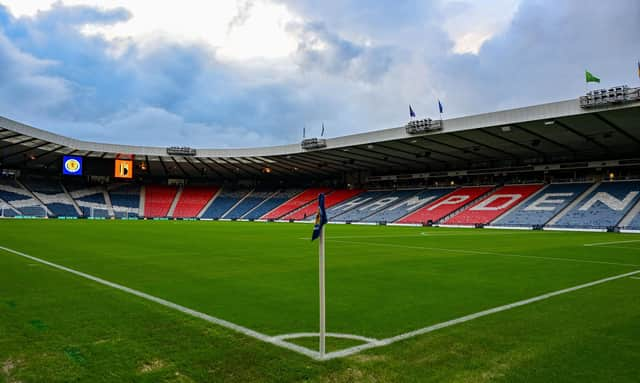Scotland and the birth of the beautiful game


It’s coming home.’ That oh-too familiar drone of England football fans, celebrating the fact that since the sport was invented in England, then if they ever win a major championship the trophy will be back in its rightful place. But ignoring the merits or otherwise of that song, we argue that if anywhere can claim to be the home of ‘the beautiful game’, it is Scotland.The rules of Association Football were written up in England in 1863, but the first mention of a ball-game in Britain comes from Wales.
A 9th-century monk called Nennius wrote that a local king, Vortigern, assembled a team of workers and materials to build a castle, but one night his equipment disappeared. He collected the materials again, and again they were taken. When it happened for a third time, he sought help from his advisors, who (somewhat bloodthirstily) said the only way to stop the thefts was sacrifice a child who had been born without a father.
Advertisement
Hide AdThe king sent messengers to find such a kid, and they came across a group of boys arguing over a ball-game. Overhearing one of the children say to another, ‘O boy without a father, no good will ever happen to you,’ the messengers kidnapped the boy and took him to the king, who (spoiler alert) spared his life, with that child going on to become the famous magician Merlin.
The first use of the word ‘football’ in English referred to them being banned. In 1314, mayor of London Nicholas de Farndone, wrote on behalf of Edward II, who was in Scotland for a battle, that: ‘Whereas there is great uproar in the City [..] arising from the striking of great footballs in the fields [..] we do command and do forbid [..] that such game be practiced henceforth within the City . . .’
Richard II and Henry V also banned the sport because it interfered with archery practice, and in 1424, James I of Scotland decreed ‘na man play at the Fute-ball’.These bans were eventually repealed, and various games known as football, but none of which particularly resemble today’s sport, were enjoyed on both sides of the border.
Sometimes they took place at the border itself. In 1599, two groups – one from each country – organised a game with the result that three Englishmen were killed, 30 were taken prisoner, and ‘many were sore hurt, especially John Whytfield whose bowels came out, but were sowed up again’.Still not what you would call ‘the beautiful game’; indeed you’d still be hard pushed to use that phrase to describe the football played in the late 19th century. Matches involved a mass of brawny men guarding the ball as they marched to their opponent’s goal, the other team all the while trying to barge them out of the way so they could start their own attack in the opposite direction. That’s the style of game the England men’s football team expected for their match against Scotland in Glasgow in 1874. It was the third game between the teams, and after the first two ended in a 0-0 draw and a 4-2 win, England had the upper hand.The weather was fine, and 8,000 spectators cheered the teams onto the pitch at exactly 3:30pm. The sides would be recognisable to today’s fans: Scotland in their familiar dark blue shirts and white shorts; England all in white. The only differences: the English wore blue caps throughout the game, and every player on the pitch had differently coloured socks. The organisers handed out leaflets that listed the players and their sock colours so that you could identify them.The game began as expected. English forwards powered their way into Scottish territory, while Scottish players attempted to repel them. After 22 minutes, there was an almighty scramble in front of the Scottish goal and the ball rebounded off the chest of English attacker Robert Kingsford and into the goal. 1-0 to the Three Lions.
That goal served only to get the Scottish fans going, which in turn inspired their players. Suddenly, they adopted a tactic that the English had never seen before: they started to pass the ball. The English sporting newspaper Bell’s Life reported: ‘What the Scots lacked in weight was amply made up in swiftness and playing-together power [..] in a way that completely astonished their opponents.’
Scotland equalised after 42 minutes, and three minutes later, striker Angus MacKinnon shot through the English goalkeeper’s legs to put his team into the lead. For all their effort and bluster, England were unable to come back, and so Scotland inflicted England’s first-ever international defeat.
Advertisement
Hide AdMore importantly, Scotland had invented a new way of playing the sport. Unlike previous tactics, this one would be recognisable as ‘football’ to today’s fans. It would evolve into the passing and moving that the great Brazilian forward Pelé was referring to when he named his autobiography The Beautiful Game, popularising the term.In 2004, Sepp Blatter, president of FIFA, claimed Ancient China as the origin of football. Some people point to games played in Italy in the Middle Ages, or in South America before European contact. But while it’s hard to disagree that England is the home of modern football, if The Beautiful Game is to ‘come home’ in next year’s European Championships, then the trophy will be in place in Hampden Park.
Everything to Play For: The QI Book of Sports by James Harkin and Anna Ptaszynski is published by Faber (£14.99 hardback).